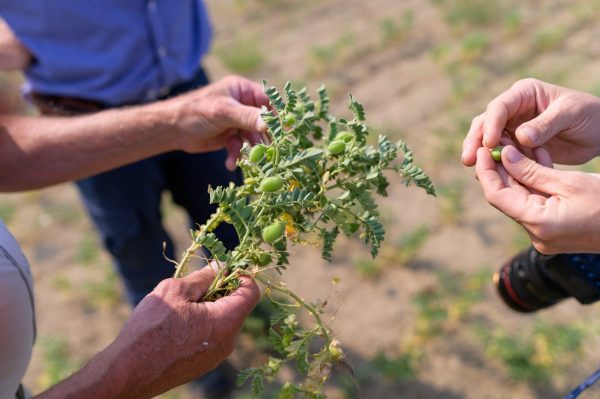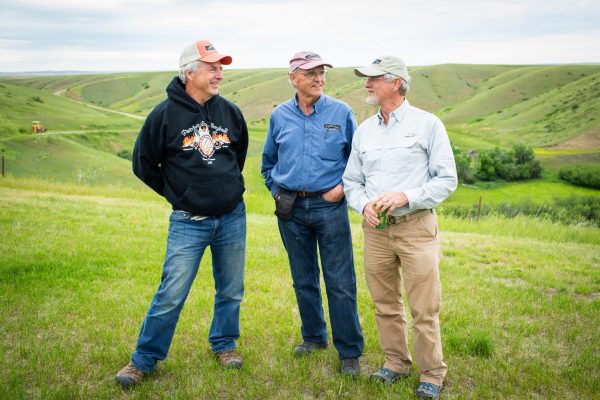Timeless Seeds’s “lentil underground” continues to grow, producing nutrient-dense specialty crops while regenerating Montana’s soils and rural communities
David Oien doesn’t seem like a renegade. He’s a friendly, down-to-earth, third-generation Montana farmer. But David and his fellow farmers at Timeless Seeds are renegades. In Montana, a state dominated by conventional wheat, David and Timeless Seeds went against the grain by growing organic lentils and other specialty crops in a region where they had never been grown before. And they’ve been successful doing it while building healthy soils on thousands of acres in Montana and helping to revive rural communities.
“We needed to build soil health”
Back in the late 1980s, David and his three fellow organic farmers, Bud Barta, Jim Barngrover, and Tom Hastings had no plans to build a business growing and selling organic lentils for food. They just wanted to build soil health.

Under Montana’s big sky, Timeless grower Jody Manuel and David Oien examine mid-season organic lentils on Jody’s farm in northcentral Montana
Wheat is king in Montana with 12 million acres of it grown each year. The state’s farmers grow wheat and then let their fields lay fallow, exposed to the elements. This combined with years of tillage badly eroded Montana’s soils. Soil organic matter, an indicator of soil health, had been 5-7% when Montana was native prairie but after many years of growing wheat, that number had fallen to 1.5%, according to David.
“We needed to rebuild fertility, soil health, organic matter, and biological activity,” David says.
The four farmers connected with Jim Sims, an agronomist at Montana State University, who had conducted research on the soil building properties of legumes, such as lentils and peas. Sims developed a self-reseeding leguminous cover crop called George Black Medic. In 1987, the farmers launched Timeless Seeds, aiming to grow and sell Black Medic as a way to help farmers rebuild Montana’s soils. But conventional farmers who were used to using synthetic nitrogen fertilizers didn’t take to the cover crop. The four farmers thought they could also sell Black Medic to the state’s organic farmers. But back then, they were few and far between.
“It was a terrible business model,” David says. “Any rational person could have seen that. But it had to be done because cover crops were needed.”
“Zero pulse crops grown in Montana”
To keep their business going, the farmers turned to growing organic lentils for food, which no one else in Montana was doing.
Protein-rich lentils have been a food source for thousands of years. Lentils are drought-resistant, making them an ideal crop to grow in Montana’s dry climate. As a legume, lentils take nitrogen from the atmosphere and convert it to a nutrient source in the soil to feed crops grown after them. When grown in rotation with other crops, lentils also help to control weeds, reducing the need for chemical herbicides.
Despite the crop’s advantages, lentils were unknown in Montana. “Back in the 1990s, there were zero pulse crops grown in Montana; west of the Rockies, there might have been a few farms. But no one grew lentils organically,” David says.
In 1994, Timeless landed a contract to supply French Green lentils to retail grocery chain Trader Joe’s, which would sell them under their own brand.
“I didn’t know who they were,” David says. “I thought the name was funky.”
With Trader Joe’s as a customer as well as a growing number of natural food stores, Timeless Seeds needed to expand into a processing facility. A grain elevator in Conrad, Montana was available to lease. David went to his bank to get a loan to lease the facility.
“The bank asked ‘What’s organic?’ and ‘What’s a lentil?’,” he says. The bank turned them down, so the farmers incorporated the business and sold shares to family and friends to raise money to lease the facility.
Unfortunately, the Trader Joe’s contract was short-lived but David saw it as a learning experience.
“To have any hope of our survival we needed more control and a line of products under our own brand,” he says.
That’s what they did, creating their own Timeless Natural Food® retail line of lentils, peas, chickpeas, and heirloom grains in 2001. The business grew, and they began sourcing lentils and other crops from more farms.

Organic chickpeas set pods in late summer in advance of early fall harvest.
Their Black Beluga Lentils®, a unique black lentil, became the best-selling lentil on the market. “It’s our calling card in the industry,” David says. “It looks like caviar.”
Timeless sells its lentils like Black Belugas to leading restaurants.
“Chefs at high-end and farm-to-table restaurants appreciate the quality and unique nutrition of our lentils,” David says.
“Unique varieties, premium quality, and nutrient density”
As the organic industry has grown, Timeless Seeds has grown with it. In 2006, the company purchased a larger, 10,000 square-foot facility in 2006 in Ulm, Montana. They increased the number of farms they source lentils from—to 40-50, an estimated 10,000-15,000 acres. The number of farms growing lentils varies each year according to the farmers’ crop rotations. The range of crops has also expanded to include grains such as farro and emmer wheats, hulless barley, Purple Prairie Barley®, Black Kabuli Chickpeas™, Black Butte Chickpeas®, and other heirloom grains.
Timeless now sells its lentils and other specialty crops to a diverse market that includes natural and specialty food distributors and stores, food manufacturers, meal kit companies, and food service such as fast casual restaurant chain, Sweetgreen. Their market has also expanded to Europe, South America, and Asia.
“Our mantra is unique varieties, premium quality and nutrient density,” David says. “Wheat is king in Montana. We don’t compete with them. We are certified organic family farmers who have the courage to do innovative crops.”
Timeless Seeds’s unique story was the subject of a popular 2015 book, Lentil Underground: Renegade Farmers and the Future of Food in America by Liz Carlisle, assistant professor in the Environmental Studies Program at University of California Santa Barbara.
“What’s in our heart is to transition more land to organic”
What started as the seed of an idea to rebuild Montana’s soils has grown to become a successful organic business creating a positive impact on the state’s farm economy.
Today, Montana—led by Timeless Seeds—grows half of America’s lentils.
David’s vision is to increase organic farmland in Montana and beyond. “What’s in our heart is to transition more land to organic production,” he says.
Timeless Seeds recently hired an agronomist, Joseph Kibiwott, to help farmers transition and to support Timeless’s farmers.
On his organic farm, David achieved his original goal—to build soil health. Soil organic matter, which reached a low of 1.5%, is now 3.5% to 4.0% after 40 years of organic farming.
“The take home message is that we can make improvements, and it takes time, patience, and markets that support that improvement in soil health,” David says. “You can impact rural economies one bite at a time.”





